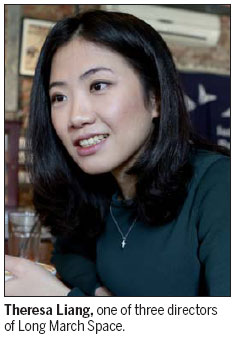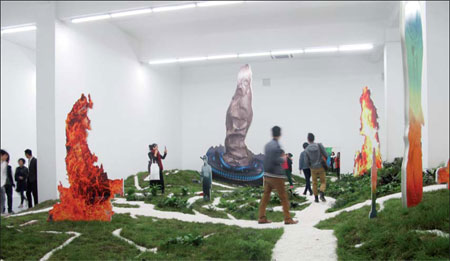Marching to the blues
Updated: 2013-05-03 08:28
By Sun Yuanqing (China Daily)
|
|||||||||||
|
The exhibits corner of Long March Space when it took part in the Frieze Art Fair London 2012. Provided to China Daily |
|
Movement Field , an installation by Xu Zhen, is exhibited at The Long March Space. Provided to China Daily |
Gallery stalwart bucks the trend with its own stable of nurtured artists
Just as a hit film can make the difference between a good year and a bad one for a production studio, or a star act can save a music label's business, so it is with galleries and their artists.
As many galleries in Beijing struggle to stay in survive, Cheng Xindong, director of the Art Gallery Association in the city, says the problem can be easily overcome "as long as you have one or two marketable artists every year".
That, of course, is much easier said than done, but instead of continually hoping an artist or two will become marketable and come to the rescue, one gallery has been nurturing its artists from its startup more than 10 years ago. The Long March Space has 18 "marketable artists", ranging from established names such as Wang Jianwei and Wu Shanzhuan to young emerging artists in Huang Ran and Hu Xiangqian.
No wonder then that when its peers were struck by the big downturn in the market last year, some falling by the wayside, The Long March happily marched through.
"Last year was better than 2011, although the rise was moderate," says Theresa Liang, one of three directors of Long March Space.
Set up in 2002, the gallery is one of the oldest in Beijing. Two-thirds of its artists come from the Long March Project, a widely acclaimed program initiated by Lu Jie, founder and director of the gallery.
Inspired by the epic Long March of the Red Army in the mid-1930s, the project investigated the contradictions and dilemmas of Chinese contemporary art, involving some of the most notable Chinese and international artists. Parts of the project have been exhibited in venues such as the National Museum of Contemporary Art in Oslo and the Museum of Contemporary Art in Lyon.
The project helped the Beijing gallery form a close kinship with the artist community, as well as extensive connections with international museums and curators, making it one of the most resourceful and respected galleries in China.
Before Long March signs an artist, the managers do a lot of research and have long discussions with the artists.
"It has to be a person who everybody feels comfortable with and acknowledges as part of the gallery," Liang says. "This is part of who we are. The artists have their own ways of doing art, but they share a common ideal, and a good gallery is the one that puts them together."

This "old-school way" of dealing with artists has also left Long March stable and intact amid the heated competition for artists as Western galleries have entered Beijing and local ones have sprung up.
"The connection between us and the artists is not all business," Liang says. "It is a long-term commitment. It's not like the relationship between a football club and a footballer. Even if there is a competitor or rumor of one (seeking to sign an artist), it doesn't bother us. Because in this gallery, we discuss everything openly."
Long March's unique perspective on contemporary art helped, too.
Among its artists is Guo Fengyi, an ink painting artist from Xi'an who died in 2010. Born in 1942, Guo did not starting painting until 1987 when her qigong (a system of breathing control, meditation and movement) practice compelled her to draw her visions. She was little known until discovered by the Long March Project in 2002. As a self-trained folk artist, Guo would normally never be included in the contemporary genre.
"It is art and nobody can argue with that," Liang says. "It has an ineffable charm that makes people want to learn more about it. And that's something that a lot of the so-called contemporary art fails to do."
Guo has been a huge success in Europe and the US. She was one of two Chinese artists whose works were picked by curator Massimiliano Gioni to feature in the Venice Biennale this year, an acknowledgement of Long March's artistic perspective.
"Anything that is contemporary can be our direction," Liang says. "And by contemporary, we mean the attitude of questioning everything that happens at the moment. We believe we should broaden the meaning of contemporary art rather than placing it high up and alienating the audience."
With confidence in its finances and professional status, the gallery embarked on a two-year expansion in 2010 when the Chinese art market started to show signs of recovery from the downturn due to the 2008 global financial crisis.
It took part in four international art fairs in 2011 in an effort to cover more markets. The numbers of Long March's international and domestic customers are now about even, making the gallery less vulnerable to economic fluctuation.
"You can't rely on domestic clients or Western clients only, because you just can't predict what will happen to the economy," Liang says.
"This is also part of our identity. We are a joint between China and the rest of the world."
While international clients are more stable, Liang sees more potential in Chinese collectors.
"Some Chinese collectors get really excited when they see newer arts like performance, and that rarely happens with Western collectors," Liang says.
"Because in the West, they've had it for a long time and nothing is new. While in China, they want to collect these new arts, but then they also start to think 'What exactly am I collecting?' And this is the interesting part, because this is where change and progress come from."
Some of the gallery's long-time Chinese collectors who started from paintings have moved on to installations. They have also learned to accept videos as a collectible medium.
"They've learned that it's fine to spend money on a Beta tape or DVD. The only question left for them now is 'Do I like it?' They no longer wonder how these could ever be sold as art."
One of the biggest challenges Long March faces is the shortage of professional gallery administrators, Liang says.
"Galleries in China are so young that we don't have much historical resources or talent to tap into. We have to learn and explore by ourselves in order to be more professional."
The gallery has trained its own registrar and archivist, important positions in a professional gallery but rarely seen among those in China.
Originally from Taiwan, Liang studied fine art at the Slade School of Fine Art, University College London, and came to Beijing to work in Long March Space in 2011 because of the appeal of the artist community in the city.
"The galleries in Europe were very sluggish at the time. Neither Taiwan nor Hong Kong really has a large artist community, and compared with Shanghai, the one in Beijing is bigger and more inclusive."
Long March is scheduled to take part in various art fairs this year, including Frieze New York and London, and Art Basel in Hong Kong, Miami Beach and Basel itself.
sunyuanqing@chinadaily.com.cn
(China Daily 05/03/2013 page18)
Today's Top News
List of approved GM food clarified
ID checks for express deliveries in Guangdong
Govt to expand elderly care
University asks freshmen to sign suicide disclaimer
Tibet gears up for new climbing season
Media asked to promote Sino-Indian ties
Shots fired at Washington Navy Yard
Minimum growth rate set at 7%
Hot Topics
Lunar probe , China growth forecasts, Emission rules get tougher, China seen through 'colored lens', International board,
Editor's Picks

|

|

|

|

|

|







